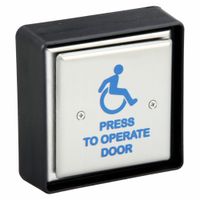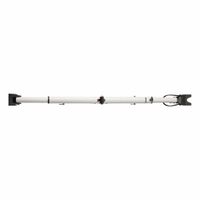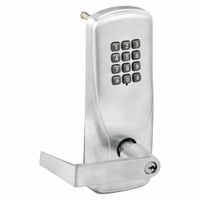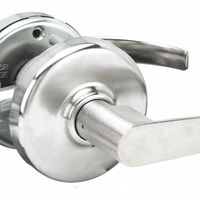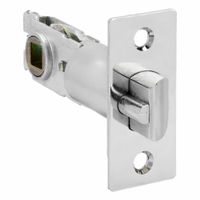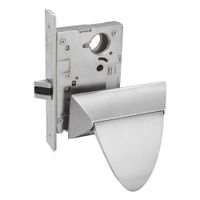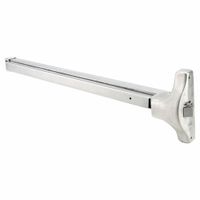Call +(254) 703 030 000 / 751 483 999 / 721 704 777
- Home
- Hardware
- Door Hardware
- Locksets Exit Devices
.....Read More
Frequently Asked Questions
What is the difference between a lockset and an exit device?
A lockset and an exit device serve different purposes in door security and access control, and they are used in different contexts.
A lockset is a hardware component that includes the lock mechanism and the handle or knob used to operate it. Locksets are typically used on interior and exterior doors to provide security and privacy. They come in various types, such as cylindrical, mortise, and tubular locksets, and can include features like key entry, deadbolts, and electronic access. Locksets are commonly found in residential and commercial settings and are designed to secure a door by preventing unauthorized entry.
An exit device, also known as a panic bar or crash bar, is a type of door hardware used on exit doors in commercial buildings to allow quick and easy egress in emergencies. Exit devices are designed to comply with building codes and safety regulations, ensuring that occupants can exit a building swiftly during emergencies like fires. They are typically installed on the interior side of doors and are operated by pushing a horizontal bar, which unlatches the door. Exit devices are often used on doors that are part of an emergency exit route and are required in many public buildings.
In summary, the primary difference lies in their function and application: locksets are used for securing doors and controlling access, while exit devices are designed for safety and emergency egress. Locksets focus on entry control, whereas exit devices prioritize safe and efficient exit.
How do keyless access locksets work?
Keyless access locksets operate using electronic mechanisms that eliminate the need for traditional keys. These systems typically use one or more of the following technologies:
1. **Keypad Entry**: Users enter a pre-set numeric code on a keypad to unlock the door. The lockset is programmed to recognize specific codes, which can be changed as needed for security.
2. **RFID (Radio Frequency Identification)**: This system uses a card or fob embedded with a microchip that communicates with the lock via radio waves. When the card or fob is within range, the lock reads the signal and unlocks if the credentials match.
3. **Bluetooth**: Smartphones or other Bluetooth-enabled devices can be paired with the lock. When the authorized device is within range, the lock communicates with it and unlocks automatically or via an app command.
4. **Biometric**: These locks use fingerprint or facial recognition technology. The lockset scans the biometric data and compares it to stored profiles. If there is a match, the door unlocks.
5. **Wi-Fi**: Some locks connect to a home or business Wi-Fi network, allowing remote access and control via a smartphone app. Users can lock or unlock the door from anywhere with an internet connection.
6. **Z-Wave or Zigbee**: These are wireless communication protocols used in smart home systems. The lock can be integrated into a smart home network, allowing control through a central hub or app.
Keyless locksets often include additional features such as temporary access codes, audit trails, and integration with other smart home devices for enhanced security and convenience. They are powered by batteries, and many models offer low-battery alerts to ensure continuous operation.
What are the benefits of electronic activation devices for doors?
Electronic activation devices for doors offer several benefits:
1. **Enhanced Security**: These devices provide advanced security features such as encryption, biometric access, and real-time monitoring, reducing the risk of unauthorized entry.
2. **Convenience**: Users can access doors without physical keys, using cards, smartphones, or biometric data, simplifying entry and reducing the need to carry multiple keys.
3. **Access Control**: They allow for precise control over who can enter specific areas and when, with the ability to easily update permissions as needed.
4. **Audit Trails**: Electronic systems can log entry and exit times, providing valuable data for security audits and monitoring employee movements.
5. **Remote Management**: Many systems offer remote access capabilities, allowing administrators to manage and monitor door access from anywhere.
6. **Integration**: These devices can be integrated with other security systems, such as alarms and surveillance cameras, for a comprehensive security solution.
7. **Scalability**: Electronic systems can be easily expanded to accommodate more doors or users, making them suitable for growing businesses.
8. **Cost-Effective**: Over time, electronic systems can be more cost-effective than traditional locks, as they reduce the need for rekeying and physical key management.
9. **Energy Efficiency**: Some systems are designed to be energy-efficient, reducing power consumption and operational costs.
10. **User-Friendly**: Modern interfaces and intuitive designs make these systems easy to use for both administrators and end-users.
11. **Emergency Features**: Many systems include emergency override options, ensuring access during power outages or other emergencies.
12. **Durability**: Electronic devices are often more durable than traditional locks, withstanding wear and tear better over time.
How do deadlatch handles function?
A deadlatch handle is a type of door hardware that combines the functionality of a latch and a lock, providing enhanced security and convenience. It operates using a spring-loaded latch bolt, which is retracted by turning the handle or knob from either side of the door. The key feature of a deadlatch is its ability to automatically lock when the door is closed, without the need for a key or manual locking.
The deadlatch mechanism consists of several components: the latch bolt, the strike plate, the handle or knob, and the locking cylinder. The latch bolt is beveled, allowing it to retract when it comes into contact with the strike plate as the door closes. Once the door is shut, the latch bolt extends into the strike plate, securing the door in place.
A key aspect of the deadlatch is the "deadlocking" feature, which prevents the latch bolt from being retracted by external force, such as a credit card or similar tool. This is achieved through an auxiliary latch, also known as a deadlocking plunger, located next to the main latch bolt. When the door is closed, the auxiliary latch is depressed by the strike plate, activating the deadlocking mechanism and securing the latch bolt in place.
To open the door from the outside, a key is typically required to disengage the locking cylinder, allowing the handle to retract the latch bolt. From the inside, the handle or knob can be turned to retract the latch bolt without a key, facilitating easy egress in case of emergency.
Overall, deadlatch handles offer a balance of security and ease of use, making them a popular choice for residential and commercial applications.
What is the purpose of exit devices and push bars on doors?
Exit devices and push bars, commonly known as panic bars, serve as crucial safety and security components in buildings. Their primary purpose is to facilitate quick and efficient egress during emergencies, such as fires or other situations requiring rapid evacuation. By allowing doors to be opened with a simple push, they enable large numbers of people to exit a building swiftly, minimizing the risk of crowding and potential injuries.
These devices are designed to comply with fire and building codes, which mandate that exit routes remain unobstructed and easily accessible. In emergency scenarios, panic can lead to chaos, and exit devices help mitigate this by providing a straightforward, intuitive means of escape. They are especially important in high-occupancy buildings like schools, hospitals, theaters, and commercial establishments.
Beyond safety, exit devices also enhance security. Many are equipped with features that prevent unauthorized entry from the outside while still allowing free egress from the inside. This dual functionality ensures that while occupants can exit quickly in an emergency, the building remains secure against intruders.
Additionally, exit devices are often designed to be durable and low-maintenance, capable of withstanding frequent use and harsh conditions. They are typically installed on doors that are part of a building's designated emergency exit routes, ensuring compliance with legal requirements and enhancing overall safety.
In summary, exit devices and push bars are essential for ensuring safe, efficient evacuation during emergencies, complying with safety regulations, and maintaining building security.
How do intruder defense systems enhance door security?
Intruder defense systems enhance door security by integrating multiple layers of protection that deter, detect, and delay unauthorized access. These systems often include advanced locking mechanisms, such as deadbolts and smart locks, which provide robust physical barriers against forced entry. Smart locks can be controlled remotely and offer features like temporary access codes, enhancing security by allowing only authorized individuals to enter.
Additionally, intruder defense systems incorporate sensors and alarms that detect unusual activities, such as door tampering or forced entry attempts. These sensors can trigger alarms to alert homeowners or security personnel, providing a rapid response to potential threats. Some systems also include video surveillance, allowing real-time monitoring and recording of activities around the door area, which can be crucial for identifying intruders and gathering evidence.
Reinforced door materials and frames are another critical component, as they resist physical attacks better than standard doors. Security doors made from steel or solid wood, combined with reinforced frames, significantly increase the time and effort required for an intruder to gain entry, acting as a strong deterrent.
Moreover, modern intruder defense systems often integrate with home automation and security networks, allowing for seamless control and monitoring through smartphones or other devices. This connectivity enables users to receive instant notifications of security breaches and manage access remotely, enhancing overall situational awareness and response capabilities.
In summary, intruder defense systems enhance door security by combining physical barriers, detection technologies, and smart connectivity to create a comprehensive security solution that protects against unauthorized access and provides peace of mind.
What factors should be considered when choosing a lockset for a door?
When choosing a lockset for a door, consider the following factors:
1. **Security Level**: Assess the security needs based on the location and purpose of the door. High-security areas require deadbolts or smart locks with advanced features.
2. **Door Type and Material**: Ensure compatibility with the door's material (wood, metal, glass) and thickness. Some locksets are specifically designed for certain materials.
3. **Lockset Type**: Choose between knob, lever, deadbolt, or smart locksets based on functionality and ease of use. Deadbolts offer higher security, while smart locks provide convenience.
4. **Grade and Certification**: Look for ANSI/BHMA grading (Grade 1, 2, or 3) to determine durability and security. Grade 1 offers the highest level of security.
5. **Aesthetics and Style**: Match the lockset with the door's design and the overall decor of the space. Consider finishes like brass, chrome, or bronze.
6. **Functionality**: Decide on the lockset function—privacy, passage, entry, or storeroom—based on the door's use. Entry locks are suitable for exterior doors, while privacy locks are ideal for bathrooms.
7. **Installation and Maintenance**: Consider ease of installation and maintenance. Some locksets require professional installation, while others are DIY-friendly.
8. **Budget**: Balance between cost and quality. Higher-priced locksets often offer better security and durability.
9. **Brand Reputation**: Choose reputable brands known for quality and reliability. Check reviews and ratings for user satisfaction.
10. **Technology Integration**: For smart locks, consider compatibility with home automation systems and features like remote access, biometric entry, or keypad entry.
11. **Weather Resistance**: For exterior doors, ensure the lockset is weather-resistant to prevent rust and wear.
12. **Warranty and Support**: Check for warranties and customer support options to ensure long-term reliability and assistance if needed.


